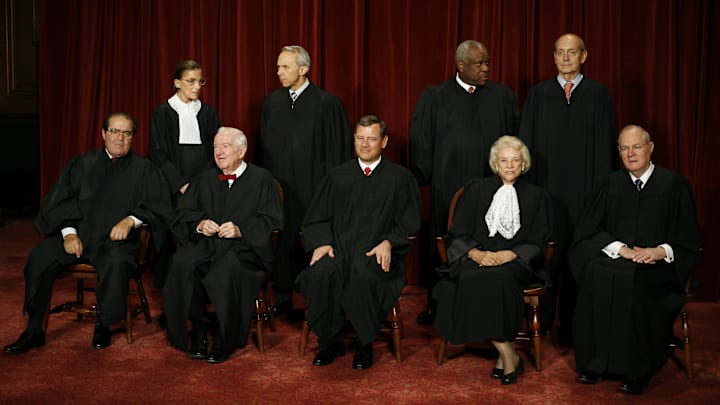There are few political appointments quite as important as a nomination to the U.S. Supreme Court. Unlike a cabinet secretary or an ambassador, justices serve for life. In the modern era, that often means more than three decades on the court. Thanks to increased lifespans, justices appointed in the next century are expected to sit on the Supreme Court for an average of 35 years, compared to the average of around 16 years that judges served in the past. Because of this shift, some scholars have begun to question whether lifetime appointments are still appropriate, as the definition of “for life” has changed so much since the Constitution was written. But why do justices serve for life, anyway?
Well, for one thing, the U.S. Constitution doesn’t exactly specify that justices and the court are in a “’til death do us part” relationship. Article III says that judges (of both the Supreme Court and lower federal courts) “shall hold their offices during good behavior.” So technically, a judge could be removed if they no longer meet the “good behavior” part of the clause, but there are otherwise no limits on their term. In practice, this means they have their seat for life, unless they are impeached and removed by Congress. Only 15 federal judges in U.S. history have ever been impeached by Congress—all lower court judges—and only eight have been removed from office, though some have resigned before their inevitable removal.
The only Supreme Court justice Congress has tried to impeach was Samuel Chase, who was appointed by George Washington in 1796. Chase was an openly partisan Federalist vehemently opposed to Thomas Jefferson’s Democratic-Republican policies, and he wasn’t afraid to say so—either in his role as a lower court judge or once he was appointed to the Supreme Court. In 1804, the House of Representatives, at then-president Jefferson’s urging, voted to impeach Chase, accusing him, among other things, of promoting his political views from the bench instead of ruling as a non-partisan judge. However, he was acquitted of all counts in the Senate, and went on to serve as a Supreme Court justice until his death in 1811.
The point of giving justices a seat on the bench for the rest of their lives (or, more commonly nowadays, until they decide to retire) is to shield the nation’s highest court from the kind of partisan fighting the Chase impeachment exemplified. The Supreme Court acts as a check against the power of Congress and the president. The lifetime appointment is designed to ensure the justices are insulated from political pressure and that the court can serve as a truly independent branch of government.
Justices can’t be fired if they make unpopular decisions, in theory allowing them to focus on the law rather than politics. Justices might be nominated because a president sees them as a political or ideological ally, but once they’re on the bench, they can’t be recalled, even if their ideology shifts. Some data, for instance, suggests that many justices actually drift leftward as they age.
The lack of term limits “is the best expedient which can be devised in any government, to secure a steady, upright, and impartial administration of the laws,” Alexander Hamilton wrote in the Federalist No. 78. The judiciary, he believed, “is in continual jeopardy of being overpowered, awed, or influenced by its coordinate branches,” and “nothing can contribute so much to its firmness and independence, as permanency in office.” Without lifetime job security, he argued, judges might feel obligated to bow to the wishes of the president, Congress, or the public, rather than confining their work strictly to questions of the Constitution.
While lifetime appointments may be a longstanding tradition in the U.S., this approach isn’t the norm in other countries. Most other democracies in the world have mandatory retirement ages if not hard-and-fast term limits for high court judges. UK Supreme Court justices face mandatory retirement at age 70 (or 75 if they were appointed before 1995), as do judges on Australia’s High Court. Canadian Supreme Court justices have a mandatory retirement age of 75, while the 31 justices of India’s Supreme Court must retire by the age of 65. Oliver Wendell Holmes Jr., the oldest justice in U.S. history, retired in 1932 at age 90.
Though the U.S. Supreme Court has never had term limits before, there have recently been serious proposals to implement them. Term limits, advocates argue, could combat partisan imbalances on the court. Presidents wouldn’t get to appoint justices purely based on whether someone died while they were in office, and the stakes for political parties nominating a justice would be slightly lower, possibly leading presidents and Congress to compromise more on appointments. One popular suggestion among political analysts and scholars is to impose an 18-year term limit, though critics note that that particular plan does bring up the potential that at some point, a single president could end up appointing the majority of the justices on the court.
In any case, considering such a change would likely require a constitutional amendment, which means it’s probably not going to happen anytime soon. For the foreseeable future, being on the Supreme Court will continue to be a lifetime commitment.
Have you got a Big Question you'd like us to answer? If so, let us know by emailing us at bigquestions@mentalfloss.com.
Discover More Facts About Government:
A version of this story originally ran in 2018; it has been updated for 2024.
